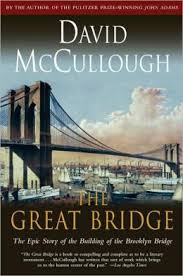Narrative Openings: Getting Nonfiction Off to a Good Start
Biff Barnes
Working on a nonfiction book? How will storytelling help you make it one people will want to read?
The fact is that most nonfiction writers don’t think of themselves as storytellers. They’re reporters putting together factual commentary on information or events, or maybe analysts investigating problems, ideas, or policies. But storytellers, not no so much.

That’s too bad because a writer, whether producing a novel or a work of nonfiction faces the same challenge of grabbing a reader’s attention and keeping him engaged. Plunging the reader into a story works well for a novelist, but it may work equally well for a nonfiction writer.
Let’s take a look at how two gifted nonfiction writers use a narrative open to hook their readers attention and draw them into the topic they will then explore.
I loved David McCullough’s book The Great Bridge about the incredible challenge of building the Brooklyn Bridge. Here are the two-time Pulitzer Prize winners opening paragraphs:
They met at his request on at least six different occasions, beginning in February 1869. With everyone present, there were just nine in all – the seven distinguished consultants he had selected; his oldest son Colonel Washington Roebling, who kept the minutes; and himself – the intense enigmatic John Augustus Roebling, wealthy wire rope manufacturer of Trenton, New Jersey and builder of unprecedented suspension bridges.
They met at the Brooklyn Gas Light Company on Fulton Street, where the new Bridge Company had begun conducting its affairs until regular offices could be arranged for. They gathered about the big plans and drawings he had on display, listening intently as he talked and asking a great many questions. They studied his preliminary surveys and the map on which he had drawn a strong red line cutting across the East River, indicating exactly where he intended to put the crowning work of his career.
I defy any reader to put the book down and not go on to find out about that crowning work. John Augustus Roebling might not have been around by the book’s end but the reader certainly will be.

Eric Beinhocker, Executive Director of the Institute for New Economic Thinking at Oxford University, wrote a recent book titled The Origin of Wealth, an excellent analysis of contemporary economic theory (albeit before the crash of 2008). It’s intended for a general audience, but it’s technical and filled with mathematical formulas and computer models. How do you get that elusive general reader to pick up a tome like this one that at first glance might seem confined to the reading list of Wall Street quants? Here’s the way Beinhocker’s opening parapgrph did it:
I sat perched on a small ledge, with my back pressed against a dung wall, in the smoky center room of a thatched hut belonging to an elderly Maasai tribesman. The hut was in a remote village in southwestern Kenya. The Maasai elder, with his wise, weather-beaten face and sharp eyes, had been asking me polite questions about my family and where I came from. Now he wanted to get the measure of me. He fixed his gaze on me across the cooking fire and asked, “How many cattle do you own?” I paused for a moment and then quietly replied, “None.” A local Maasai teacher, who had befriended me and was acting as my guide, translated my reply. There was a murmur around the small room as various members of the village, curious about the stranger, digested this piece of information. After a few moments’ consideration, the elder replied, “I am very sorry for you.” But the pity evident in his voice and on his face was also tinged with puzzlement as to how someone so poor could afford to travel such long distances and own a camera. As the discussion turned back to the questions about my family, I remarked that I have an uncle who once owned a large heard of cattle on his farm in Maryland. There was then a quick nodding of understanding as the mystery was solved – the visitor was clearly the ne’er-do-well nephew of a rich uncle, traveling and living off his relative’s bovine wealth.
The story encapsulates the idea the book will explore. The reader gets it and agrees to go along for the ride.
If you want your nonfiction book to find a wide and enthusiastic audience you will be well served if you give some thought to how storytelling will help you make your point not only at your book’s opening, but throughout.